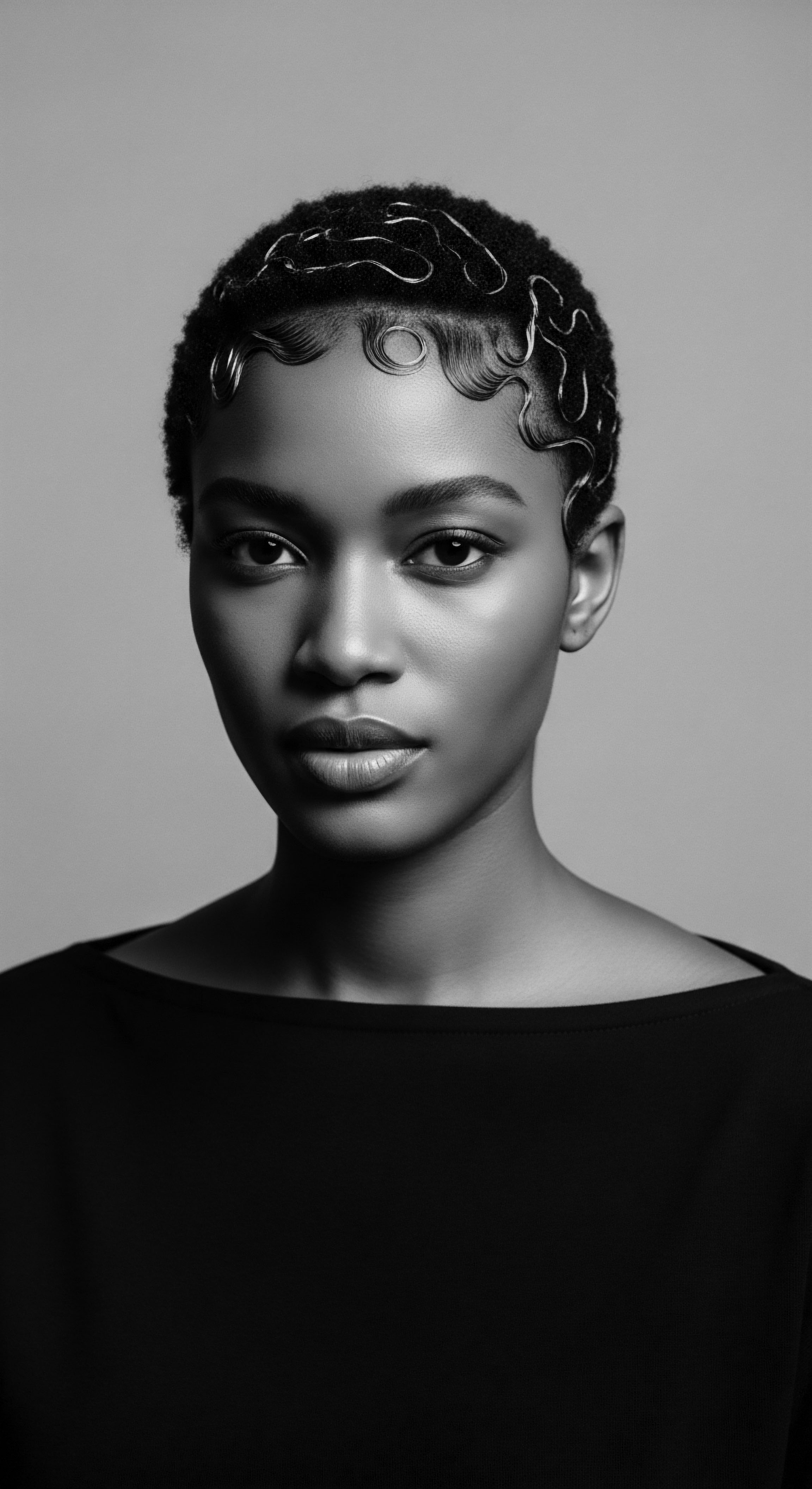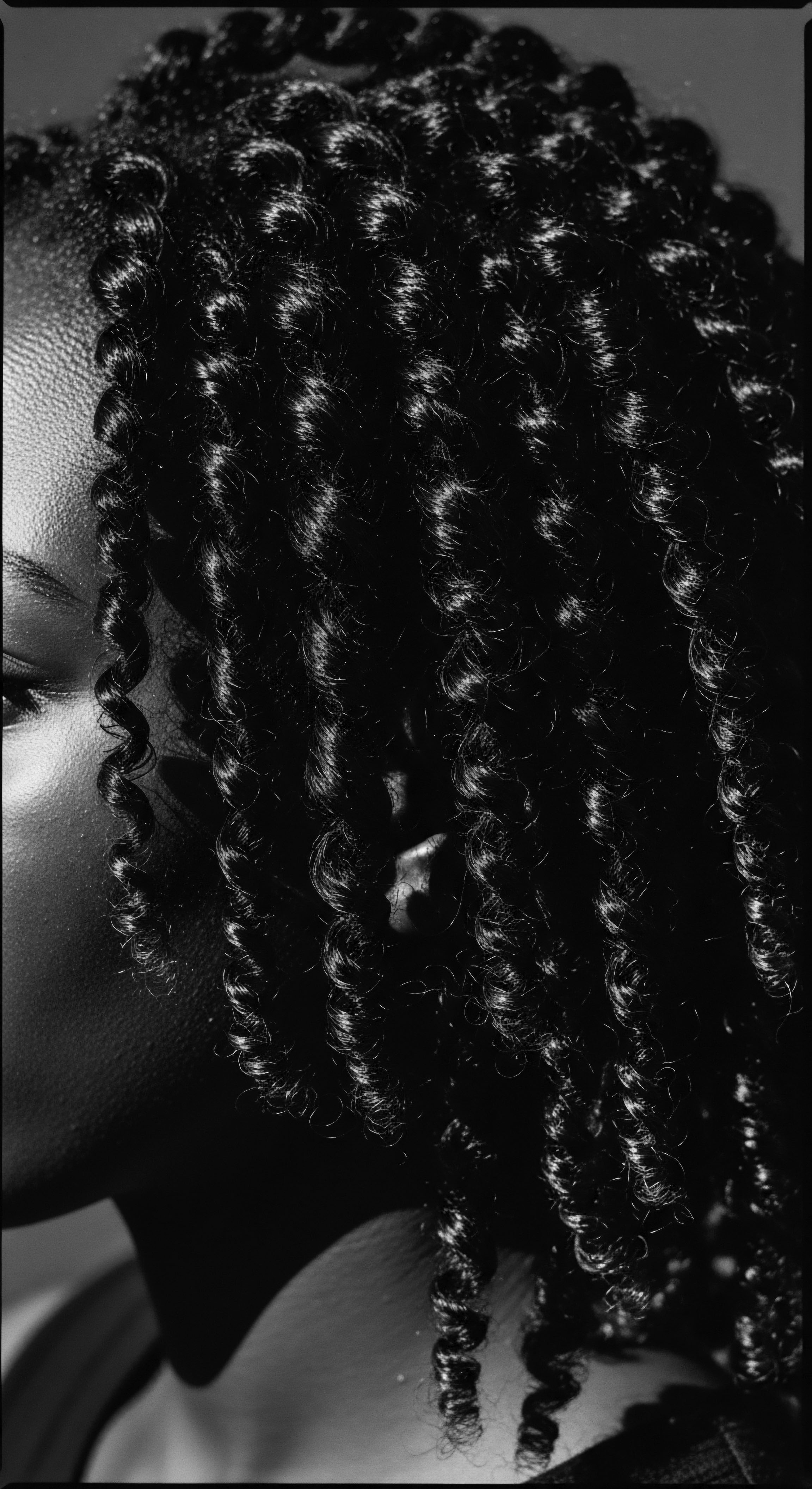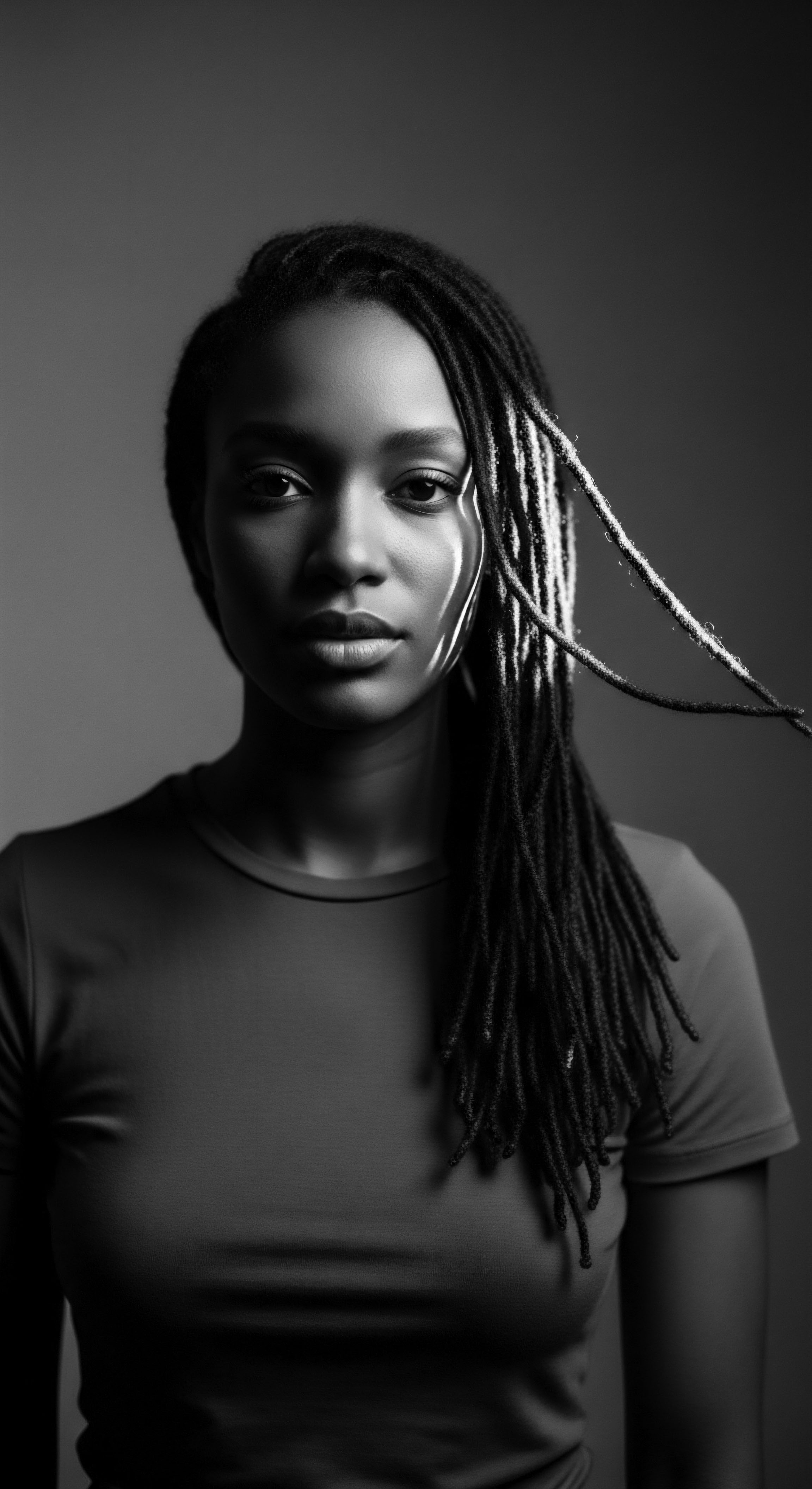
Roots
To hold a single strand of textured hair between one’s fingers is to hold an archive, a living testament to journeys spanning continents and epochs. Each curl, coil, or wave speaks a language of resilience, of adaptation, and of ancestral ingenuity. For generations uncounted, long before the advent of synthesized compounds and laboratories, the very earth provided what was needed for its care.
Our exploration into the historical role of plant materials within textured hair traditions unveils not just remedies, but rituals; not just tools, but wisdom passed hand-to-hand, heart-to-heart, across lineages. It is a dialogue with the past, a profound recognition of how botanical allies shaped the very being of our hair, intertwining with its biological makeup and the ways communities saw, celebrated, and maintained it.

Textured Hair’s Elemental Architecture
The distinct morphology of textured hair – its helical, often elliptical cross-section, its varying degrees of curl density, and its unique cuticle arrangement – presents specific needs. Unlike straighter hair types, the twists and turns along a strand of textured hair mean that natural oils, known as sebum, struggle to travel the full length from scalp to tip. This inherent characteristic makes textured hair predisposed to dryness. Ancestral communities, keenly observing these biological truths through generations of lived experience, recognized this need for external lubrication and moisture.
Their solutions were not accidental; they stemmed from deep observation of the natural world around them. The solutions came from plants, a direct response to the hair’s elemental architecture.
The story of textured hair care is etched in the very botanicals that sustained ancestral communities, mirroring the hair’s unique thirst for moisture.
Early scientific understanding, often skewed by colonial perspectives, sometimes misconstrued the inherent qualities of textured hair as fragility. Modern trichology, however, now affirms the intrinsic strength of these hair types, recognizing that proper care, often rooted in traditional methods, unlocks their vitality. The historical lexicon surrounding textured hair, from ancient African dialects describing specific curl patterns to the terms that arose within diasporic communities, frequently incorporated terms related to its density, its spring, and its luster—qualities often enhanced by plant-based treatments.

Botanical Allies in Ancient Care
Across various ancestral lands, indigenous knowledge systems identified specific plants with properties suited for hair care. From the nourishing butters of the shea tree in West Africa to the conditioning mucilage of aloe vera common in various arid regions, plant materials were not merely cosmetic additions. They were fundamental components of health, hygiene, and ritual. These botanical allies offered fatty acids, humectants, saponins, and other natural compounds that addressed the hair’s particular requirements.
Consider the Shea Tree, Vitellaria paradoxa, native to the savanna belt of West and Central Africa. Its butter, painstakingly extracted from the nuts, has been a cornerstone of hair and skin care for millennia. Its rich content of triterpenes, tocopherol, phenols, and sterols grants it remarkable emollient and anti-inflammatory properties (Maranz & Wiesman, 2003). For textured hair, this meant an unparalleled ability to seal in moisture, reduce breakage, and soothe the scalp.
It was, and remains, a protective balm against environmental stressors. In many communities, the shea butter process was a communal undertaking, passed from elder women to younger generations, binding care rituals with social fabric.
- Shea Butter ❉ A rich emollient sourced from the nuts of the shea tree, vital for moisture retention and scalp soothing.
- Coconut Oil ❉ Valued for its ability to penetrate the hair shaft, providing deep conditioning and reducing protein loss.
- Aloe Vera ❉ Its gel provides hydration, calms scalp irritation, and helps define curl patterns.
The application of these materials wasn’t haphazard. It was systematic, often tied to specific growth cycles or life stages. Young children received scalp massages with infused oils to encourage healthy growth, adolescents used plant washes to cleanse and define their emerging styles, and adults relied on heavier butters and pastes for protective styles and maintaining length. This continuum of care, stretching across a lifetime, was deeply intertwined with the botanical bounty of their surroundings.
| Plant Material Shea Nut Butter |
| Traditional Application Applied as a protective balm and moisturizer |
| Primary Hair Benefit Deep conditioning, breakage reduction, scalp soothing |
| Plant Material Hibiscus Flowers (dried, ground) |
| Traditional Application Used in hair washes and rinses |
| Primary Hair Benefit Natural cleansing, conditioning, adds gloss |
| Plant Material Baobab Seed Oil |
| Traditional Application Massaged into scalp and strands |
| Primary Hair Benefit Nourishing fatty acids, elasticity enhancement |
| Plant Material Amla Fruit (dried, powdered) |
| Traditional Application Hair masks and scalp treatments |
| Primary Hair Benefit Scalp health, fortifies strands, premature graying prevention |
| Plant Material These botanical selections highlight the thoughtful use of nature's offerings in historical hair care. |
The practice of infusing oils with herbs, common across various traditions, speaks to an early understanding of extraction and synergy. Leaves, roots, and flowers were steeped in carrier oils, allowing their beneficial compounds to infuse into a usable form. This was not merely about fragrance; it was a sophisticated method for delivering nutrients, promoting blood circulation to the scalp, and strengthening hair fibers. These ancestral preparations formed the very foundation of textured hair care, their efficacy proven through countless generations of use and observed results.

Ritual
The application of plant materials in textured hair traditions transcended mere product use; it manifested as a rich tapestry of ritual, deeply interwoven with cultural identity and community bonding. These were not quick fixes but deliberate, often communal practices, embodying patience, reverence, and shared knowledge. The methods for preparing and applying these botanical elements shaped styling techniques and were integral to transformations, both aesthetic and symbolic. The hand that tended the hair, often guided by ancestral wisdom, understood that the rhythm of care mirrored the rhythms of life itself.

Styling Techniques and Botanical Influence
Traditional textured hair styles, many of which find echoes in contemporary protective looks, relied heavily on the pliable nature of hair softened and conditioned by plant materials. Styles like intricate braids, coils, and twists required hair that was not only clean but also deeply moisturized to prevent breakage during manipulation. Plant butters and oils served as vital lubricants, allowing fingers to glide through dense hair, preventing friction and facilitating precise sectioning and shaping.
Consider the ancient practice of Threading, common in parts of West Africa, where thread (often made from natural fibers) is wrapped tightly around sections of hair. This technique, used to stretch and elongate curls without heat, demanded hair that was supple and protected. Before threading, hair would often be treated with a mixture of shea butter, palm oil, or other local botanical concoctions to nourish the strands and minimize stress. This preparatory step was as crucial as the threading itself, ensuring the hair remained healthy and resilient.
The artistry of traditional textured hair styling found its foundation in plant materials, enabling intricate forms and preserving strand integrity.

The Historical Role of Plant Washes
Long before commercial shampoos, plant materials provided effective means for cleansing and conditioning. Many plants contain natural saponins, compounds that create a gentle lather and help remove dirt and excess oil without stripping the hair of its vital moisture. The use of various barks, leaves, and roots for hair washes speaks to a sophisticated understanding of plant chemistry within ancestral communities.
For instance, the bark of the Chebe Tree (known for its application in Chad, particularly among the Basara women) is not a cleansing agent, but its companion, the Karkar Oil, often mixed with other plant elements like musk and mahaleb, was used as part of a ritualized application to lubricate and strengthen hair. While chebe itself is a powder applied to the hair, it is the oil-based preparation that seals in moisture and allows the hair to retain length over time. The entire regimen, which includes applying plant-derived oils and powders to braided hair, works to reduce breakage by keeping the hair consistently conditioned and protected (Abana, 2020). This specific Chadian tradition beautifully illustrates how plant materials, even those not directly from the plant itself but combined with it, form the bedrock of styling and preservation practices.

Plant-Based Ingredients for Cleansing and Conditioning
Beyond simple washes, various plant elements were incorporated into pre-wash treatments and rinses to condition and soften hair. This allowed for easier detangling and manipulation, which is particularly important for hair with tighter coil patterns that are prone to knotting.
- Rhassoul Clay ❉ A mineral-rich clay from Morocco, often mixed with water and botanicals, serving as a gentle cleanser and detoxifier for scalp and hair.
- Fenugreek Seeds ❉ Soaked and ground, their mucilaginous properties create a slip that aids in detangling and adds conditioning.
- Cassia Obovata ❉ Known as “neutral henna,” this plant powder conditions, adds shine, and provides strength without depositing color.
The intentionality behind these choices reveals a deep knowledge of botany and a practical, generational wisdom regarding hair health. The preparations often involved macerating, boiling, or infusing plant parts, transforming raw materials into potent elixirs. These historical traditions underscore the enduring connection between the earth’s offerings and the profound care extended to textured hair.

Relay
The historical relay of plant material knowledge for textured hair care stretches across generations and geographies, manifesting as both a continuum of ancestral wisdom and an adaptation to new environments. This transmission of knowledge was not static; it evolved with migrations, cultural fusions, and the relentless pursuit of healthy hair. Understanding this relay means appreciating the resilience of practices that transcended oppressive eras and continued to nourish both hair and spirit.

Ancestral Wellness Philosophies
The application of plant materials for textured hair was seldom isolated from broader ancestral wellness philosophies. Hair care was often viewed as an extension of overall health, spirituality, and connection to the earth. In many African societies, hair held symbolic weight, signifying status, marital standing, or even readiness for battle. Therefore, its care, often with plant-derived ingredients, was a sacred act.
The wisdom embedded in these practices was often experiential, passed down through observation and oral tradition rather than written texts. Grandmothers and mothers were the primary custodians of this knowledge, teaching younger generations the precise feel of conditioned hair, the correct consistency of a plant paste, or the specific aroma of a potent herbal infusion. This intimate, intergenerational transfer ensured the longevity of these traditions.

Plant Materials in Diaspora Hair Traditions
As African peoples were forcibly dispersed across the diaspora, they carried with them not only their physical selves but also their knowledge systems. In new lands, faced with unfamiliar flora and challenging circumstances, they adapted. This meant identifying new indigenous plants that shared similar properties with the botanicals of their homelands or finding ways to access familiar ingredients through trade. The story of plant materials in textured hair care in the diaspora is thus one of profound resourcefulness and cultural continuity.
Consider the role of Okra (Abelmoschus esculentus) in the Americas and the Caribbean. While not traditionally a hair care ingredient in West Africa, its mucilaginous properties, when boiled, provided a natural slip and conditioning agent remarkably similar to what might have been gained from other botanical sources in Africa. This adaptation highlights the ingenuity of enslaved and free Black populations in creating effective hair care solutions from available resources, mirroring the conditioning properties found in plants like slippery elm bark or marshmallow root (Walker, 2017). This specific adaptation became a new branch of heritage, born of necessity and innovation.
Through the diaspora, the spirit of botanical hair care adapted, finding new allies in plants like okra to preserve ancestral practices.

Adaptation and Innovation in Plant-Based Hair Care
- Avocado ❉ Rich in fatty acids and vitamins, its pulp was mashed and used as a conditioning hair mask in many Latin American and Caribbean traditions, substituting for heavier butters.
- Flaxseeds ❉ Boiled to produce a slippery gel, these seeds offered a natural alternative to commercial styling gels, providing hold and definition for curls.
- Bay Rum Leaves ❉ Infused in tonics, these leaves were used for scalp stimulation and to promote hair growth in some Caribbean communities.
The integration of these new plant materials into existing care philosophies speaks volumes about the dynamic nature of heritage. It demonstrates that tradition is not static but a living, breathing entity that evolves while retaining its core principles. The understanding of plant properties, initially rooted in specific ecosystems, expanded to encompass new botanical discoveries, all serving the enduring need for specialized textured hair care.

Modern Science Meets Ancestral Wisdom
Today, modern scientific research frequently validates the efficacy of many traditional plant-based hair care practices. The compounds identified in shea butter, coconut oil, aloe vera, and countless other botanicals are now studied for their precise molecular effects on hair structure, moisture retention, and scalp health. This scientific corroboration reinforces the deep empirical knowledge cultivated by ancestral communities.
For instance, the ability of Coconut Oil to penetrate the hair shaft, reducing protein loss (Rele & Mohile, 2003), was understood through observation and millennia of use long before chromatography or electron microscopes confirmed its unique molecular structure. The ancestral application of it for deep conditioning was a testament to observational science, a profound understanding gained through intimate interaction with nature.
This relay of knowledge, from ancient empirical practice to contemporary scientific validation, underscores the timeless value of plant materials. They represent a heritage of care, a legacy of resourcefulness, and a continuous source of inspiration for nurturing textured hair in all its glorious forms. The wisdom of the plants, held in the hands of our ancestors, continues to inform our hair journeys today.

Reflection
To journey through the historical role of plant materials in textured hair traditions is to realize that our strands are more than just fibers; they are profound extensions of our heritage. They carry the whispers of the wind through shea trees, the resilience of the aloe in arid lands, the adaptive spirit of okra in new soils. This exploration reveals a truth that Roothea seeks to honor with every offering ❉ the deepest care for textured hair begins not in a laboratory, but in the earth, and in the wisdom passed down from those who understood its language.
The legacy of plant materials is a powerful reminder that wellness is interconnected—hair health tied to the land, to community, to identity. Our ancestors, through their intimate communion with nature, developed a sophisticated lexicon of botanical solutions, remedies that were gentle, effective, and deeply respectful of the hair’s intrinsic design. This enduring connection serves as a profound source of strength and guidance for us today, inviting us to cultivate our own relationship with these timeless allies, recognizing the sacred in every strand. Our textured hair, sustained by the earth’s bounty, continues its story, a living, breathing archive of ancestral love and knowledge.

References
- Abana, S. (2020). Hair Story ❉ Untangling the Roots of Black Hair in America. New York, NY ❉ St. Martin’s Press.
- Maranz, S. & Wiesman, Z. (2003). The Shea Butter Industry ❉ A Comprehensive Handbook. Boca Raton, FL ❉ CRC Press.
- Rele, V. L. & Mohile, R. B. (2003). Effect of mineral oil, sunflower oil, and coconut oil on prevention of hair damage. Journal of Cosmetic Science, 54(2), 175-192.
- Walker, A. (2017). The Natural Hair Handbook ❉ A Guide to Natural Hair Care for Beginners. New York, NY ❉ Createspace Independent Publishing Platform.
